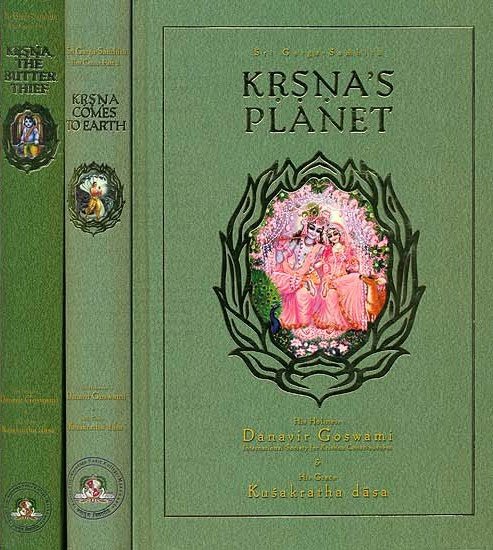Garga Samhita (English)
by Danavir Goswami | 425,489 words
The Garga-samhita Verse 5.8.35, English translation, including word-by-word: This text represents a Vaishnava scripture which narrates the life Krishna, It was composed in seventeen cantos by Garga Muni: an ancient sage and priest of the Yadu dynasty having. This is verse 5 of Chapter 8 (The Killing of Kamsa) of Canto 5 (mathura-khanda).
Verse 5.8.35
Sanskrit text, transliteration and word-by-word meaning:
हा-हा-कारस् तदैवासीद्
धावतां भुभुजां नृप
वैर-भावेन देवेशं
भजन् कंसो महा-बलः
जगाम तस्य सारूप्यं
भृङ्गिनः कीटको यथा
hā-hā-kāras tadaivāsīd
dhāvatāṃ bhubhujāṃ nṛpa
vaira-bhāvena deveśaṃ
bhajan kaṃso mahā-balaḥ
jagāma tasya sārūpyaṃ
bhṛṅginaḥ kīṭako yathā
hā-hā-kāraḥ—the sound ofAlas! Alas!; tadā—then; eva—indeed; āsīt—was; dhāvatām—running; bhubhujām—of the kings; nṛpa—O king; vaira-bhāvena—with enmity; deveśam—the Supreme Personality of Godhead; bhajan—worshiping; kaṃsaḥ—Kaṃsa; mahā-balaḥ—very strong; jagāma—went; tasya—of Him; sārūpyam—the same form; bhṛṅginaḥ—of a bee; kīṭakaḥ—a kitaka insect; yathā—as.
English translation of verse 5.8.35:
O king, the many kings ran here and there, exclaiming, Alas! Alas!" Then because in the rasa of hatred he had worshiped Lord Kṛṣṇa, the master of the demigods, Kaṃsa attained a spiritual form resembling the Lord's, as a kiṭaka insect attains the form of it's enemy, the bee.
